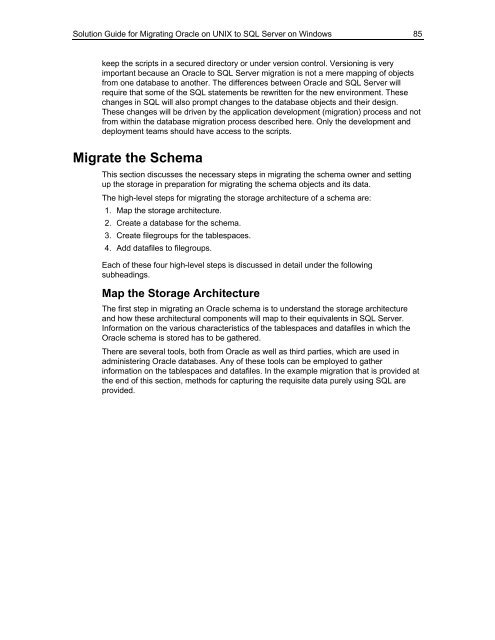Solution Guide for Migrating Oracle on UNIX to SQL Server - Willy .Net
Solution Guide for Migrating Oracle on UNIX to SQL Server - Willy .Net
Solution Guide for Migrating Oracle on UNIX to SQL Server - Willy .Net
- No tags were found...
You also want an ePaper? Increase the reach of your titles
YUMPU automatically turns print PDFs into web optimized ePapers that Google loves.
<str<strong>on</strong>g>Soluti<strong>on</strong></str<strong>on</strong>g> <str<strong>on</strong>g>Guide</str<strong>on</strong>g> <str<strong>on</strong>g>for</str<strong>on</strong>g> <str<strong>on</strong>g>Migrating</str<strong>on</strong>g> <str<strong>on</strong>g>Oracle</str<strong>on</strong>g> <strong>on</strong> <strong>UNIX</strong> <strong>to</strong> <strong>SQL</strong> <strong>Server</strong> <strong>on</strong> Windows 85keep the scripts in a secured direc<strong>to</strong>ry or under versi<strong>on</strong> c<strong>on</strong>trol. Versi<strong>on</strong>ing is veryimportant because an <str<strong>on</strong>g>Oracle</str<strong>on</strong>g> <strong>to</strong> <strong>SQL</strong> <strong>Server</strong> migrati<strong>on</strong> is not a mere mapping of objectsfrom <strong>on</strong>e database <strong>to</strong> another. The differences between <str<strong>on</strong>g>Oracle</str<strong>on</strong>g> and <strong>SQL</strong> <strong>Server</strong> willrequire that some of the <strong>SQL</strong> statements be rewritten <str<strong>on</strong>g>for</str<strong>on</strong>g> the new envir<strong>on</strong>ment. Thesechanges in <strong>SQL</strong> will also prompt changes <strong>to</strong> the database objects and their design.These changes will be driven by the applicati<strong>on</strong> development (migrati<strong>on</strong>) process and notfrom within the database migrati<strong>on</strong> process described here. Only the development anddeployment teams should have access <strong>to</strong> the scripts.Migrate the SchemaThis secti<strong>on</strong> discusses the necessary steps in migrating the schema owner and settingup the s<strong>to</strong>rage in preparati<strong>on</strong> <str<strong>on</strong>g>for</str<strong>on</strong>g> migrating the schema objects and its data.The high-level steps <str<strong>on</strong>g>for</str<strong>on</strong>g> migrating the s<strong>to</strong>rage architecture of a schema are:1. Map the s<strong>to</strong>rage architecture.2. Create a database <str<strong>on</strong>g>for</str<strong>on</strong>g> the schema.3. Create filegroups <str<strong>on</strong>g>for</str<strong>on</strong>g> the tablespaces.4. Add datafiles <strong>to</strong> filegroups.Each of these four high-level steps is discussed in detail under the followingsubheadings.Map the S<strong>to</strong>rage ArchitectureThe first step in migrating an <str<strong>on</strong>g>Oracle</str<strong>on</strong>g> schema is <strong>to</strong> understand the s<strong>to</strong>rage architectureand how these architectural comp<strong>on</strong>ents will map <strong>to</strong> their equivalents in <strong>SQL</strong> <strong>Server</strong>.In<str<strong>on</strong>g>for</str<strong>on</strong>g>mati<strong>on</strong> <strong>on</strong> the various characteristics of the tablespaces and datafiles in which the<str<strong>on</strong>g>Oracle</str<strong>on</strong>g> schema is s<strong>to</strong>red has <strong>to</strong> be gathered.There are several <strong>to</strong>ols, both from <str<strong>on</strong>g>Oracle</str<strong>on</strong>g> as well as third parties, which are used inadministering <str<strong>on</strong>g>Oracle</str<strong>on</strong>g> databases. Any of these <strong>to</strong>ols can be employed <strong>to</strong> gatherin<str<strong>on</strong>g>for</str<strong>on</strong>g>mati<strong>on</strong> <strong>on</strong> the tablespaces and datafiles. In the example migrati<strong>on</strong> that is provided atthe end of this secti<strong>on</strong>, methods <str<strong>on</strong>g>for</str<strong>on</strong>g> capturing the requisite data purely using <strong>SQL</strong> areprovided.
















